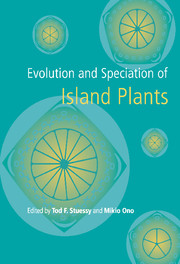Book contents
- Frontmatter
- Contents
- List of contributors
- Preface
- Acknowledgements
- Part one Hawaiian Islands
- Part two Juan Fernandez Islands
- Part three Southern and western Pacific Islands
- Introduction
- 6 Genetic diversity of the endemic plants of Bonin (Ogasawara) Islands
- 7 Evolution of cryptic dioecy in Callicarpa (Verbenaceae) on the Bonin Islands
- 8 Conservation of the endemic vascular plant species of the Bonin (Ogasawara) Islands
- 9 Preliminary observations on the evolution of endemic angiosperms of Ullung Island, Korea
- 10 Evolution in Crossostylis (Rhizophoraceae) on the South Pacific Islands
- Part four General evolutionary patterns and processes on oceanic islands
- Author index
- Taxon index
- Subject index
9 - Preliminary observations on the evolution of endemic angiosperms of Ullung Island, Korea
Published online by Cambridge University Press: 04 May 2010
- Frontmatter
- Contents
- List of contributors
- Preface
- Acknowledgements
- Part one Hawaiian Islands
- Part two Juan Fernandez Islands
- Part three Southern and western Pacific Islands
- Introduction
- 6 Genetic diversity of the endemic plants of Bonin (Ogasawara) Islands
- 7 Evolution of cryptic dioecy in Callicarpa (Verbenaceae) on the Bonin Islands
- 8 Conservation of the endemic vascular plant species of the Bonin (Ogasawara) Islands
- 9 Preliminary observations on the evolution of endemic angiosperms of Ullung Island, Korea
- 10 Evolution in Crossostylis (Rhizophoraceae) on the South Pacific Islands
- Part four General evolutionary patterns and processes on oceanic islands
- Author index
- Taxon index
- Subject index
Summary
Abstract
Ullung Island is located 150 km east of Korea in the East Sea at 37° N latitude. The island is of volcanic origin, 73km2 in area and approximately 1.8 million years old. Ullung Island contains 700 species of vascular plants of which 37 angiosperms are endemic. Closest phytogeographic ties of the island flora are with South Korea and Central Japan. This chapter offers preliminary observations on relationships of Ullung Island endemics with presumptive source-area relatives. Initial assessments of morphological changes suggest a tendency towards increased stature in island taxa as well as a loss of pubescence and prickles (e.g., in Rubus takesimana). Detailed morphological comparisons using principal components analysis of the endemic Hepatica maxima and close congeners in northeastern Asia support further the observed trends. New chromosome counts are presented for 48 taxa of Ullung Island, including first reports for eight species, representing 40% of the native and endemic angiosperms. These data, in consort with previously published cytological information regarding presumptive relatives, suggest that few aneuploid or euploid changes have occurred during speciation of the angiosperm flora on this island. The endemic angiosperms of Ullung Island appear mostly to have evolved by simple anagenesis, there being little evidence of intra-island cladogenetic speciation events.
Ullung Island is a small island 150 km east of mainland Korea and 300 km west from Japan (Fig. 9.1), extending from 37°27′ to 37°33′ N and from 130°47′ to 130°56′ E.
- Type
- Chapter
- Information
- Evolution and Speciation of Island Plants , pp. 181 - 202Publisher: Cambridge University PressPrint publication year: 1998
- 18
- Cited by



